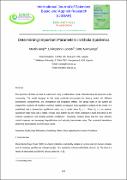| dc.contributor.author | Arop, Martin | |
| dc.contributor.author | Luboobi, Livingstone | |
| dc.contributor.author | Nannyonga, Betty | |
| dc.date.accessioned | 2018-06-05T13:10:42Z | |
| dc.date.available | 2018-06-05T13:10:42Z | |
| dc.date.issued | 2016 | |
| dc.identifier.citation | Arop, Martin, Luboobi, Livingstone, & Nannyonga, Betty. (2016). Determining Important Parameters in Ebola Epidemics. International Journal of Sciences: Basic and Applied Research (IJSBAR), 28(2), 169–183. Retrieved from http://gssrr.org/index.php?journal=JournalOfBasicAndApplied&page=article&op=view&path%5B%5D=5756&path%5B%5D=2960 | en_US |
| dc.identifier.issn | 23074531 | |
| dc.identifier.uri | | |
| dc.description.abstract | The dynamics of Ebola can best be understood using a mathematical model that determines its dynamics in the community. The model designed in this study explicitly incorporates the latency period, the different transmission compartments, and immigration and emigration effects. The steady states of the system are analysed for existence of equilibria and their stability investigated. From qualitative analysis of the model, it is established that a disease-free equilibrium exists and is stable when ℛ0<1. When ℛ0>1, an endemic equilibrium state exists and is stable. Results show further that the model undergoes a hopf bifurcation at the endemic equilibrium and exhibits periodic oscillations. Sensitivity analysis shows that the most effective control measures are increasing hospitalization and reducing transmission rates. The numerical simulations performed demonstrated the theoretical results. | en_US |
| dc.language.iso | en | en_US |
| dc.publisher | International Journal of Sciences: Basic and Applied Research (IJSBAR) | en_US |
| dc.relation.ispartofseries | Vol.28;No.2 | |
| dc.subject | Ebola | en_US |
| dc.subject | Hopf bifurcation | en_US |
| dc.subject | Sensitivity indices | en_US |
| dc.subject | Basic reproductive number | en_US |
| dc.subject | Prevalence | en_US |
| dc.title | Determining important parameters in Ebola epidemics | en_US |
| dc.type | Article | en_US |

